by Mary E. Ulrich | Apr 13, 2016
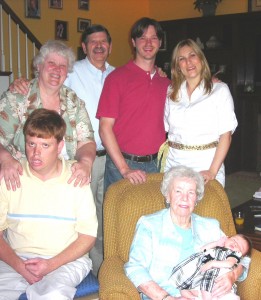
Aaron and 4 Generations of Family
“If you don’t design your own life plan, chances are you’ll fall into someone else’s plan. And guess what they have planned for you? Not much.” – Jim Rohn
I will soon be celebrating my 66th Birthday. I used to think 66 was old. Now I just think 66 is experienced with a lot of living yet to do.
I wonder what the world will be like when Aaron, Tommy, Ana and even little Isabella turn 66? When I blow out my candles, I’m wishing with all my heart the world will be inclusive. And, we’ll all be part of a caring community who values diversity and individual contributions because together we are stronger.
In Part 1: 1981 Aaron was 6 years old and we outlined a vision of what a happy, successful quality of life would look like for Aaron as an adult. (click here).
In Part 2: 1989, Aaron was 14 years old and we were moving forward. The Plan was updated to take into account the changes in our family, but also the changes in special education, disability services and the world. (click here)
In Part 3: 1998 Aaron is 23 years old and moving out of his parent’s house into his own place with a roommate and 24 hour assistance from caregivers. (Click here)
In Part 4: 2016:
How did we do?
All Dream Plans were built on the concepts of family, community, normalization and inclusion.
Original 1981 Dream Plan for Aaron
Aaron will be educated in a public school with his non-handicapped brother and neighbors. He will have a functional curriculum (see related post) which looks at his needs in his life spaces (vocational, leisure/recreation, domestic, general community functioning). His out-of-school activities will evolve around his family and his own friends, interests and talents. He will be in age-appropriate settings: elementary school ages 5-10; Jr. High ages 11-13, Sr. High ages 14-21, job in the community 21+. He will begin vocational training now, at age 6, so he will be able to perform the job. (If he isn’t able to be a dishwasher, then he can be a dishwasher’s helper, etc… there is some job he will be able to do with success.) At the appropriate time, Aaron will move to a group home to live with others his age. Though dependent in many ways, Aaron will have self-esteem and confidence in the things he does and be a contributor to his family, his extended family, and society.
Current 2010 Dream Plan for Aaron
Aaron was educated in a public school with his brother and the neighbors. After we won our lawsuit with Cincinnati Public Schools, the school district was vindictive and since Tom (Aaron and Tom’s father) was a teacher in the district we decided to move to Lakota School District. Aaron rode the bus to school with the neighborhood kids, he received a functional community based program with some excellent teachers and therapists who used best practice. His out-of-school activities evolved around his family and his own friends, interests and talents. Aaron went to the prom with his friend Jenni, he was on the Jr. High Track and Cross Country team where he earned school letters, he rode horses, swam, went to camp and took summer vacations with his family. He went to family reunions, holiday parties and the high school basketball and football games. He was on an inclusive bowling team and made some friends with the Baseball Team players. He was in the Key Club and had a circle of friends. He received extended school year services. He attended graduation (see related article) and had a celebration for all his family and friends. Aaron went to age-appropriate schools and had a job coach to help him in his job at the police station (vacuuming) and amusement park (watering plants) when he left school. When Aaron was 23 he moved into a house with another person (though he was older) and they have lived together for over 12 years. Aaron is still totally dependent but he has self-esteem and confidence in the things he does. He is loved and is a contributor to his family which now includes a niece and sister-in-law as well as his extended family of grandma and cousins. Aaron votes and is a consumer in our society.
Each one of these sentences is filled with years of work and advocacy. There are a whole lot of buts, buts, and more buts that happened when Aaron turned 21 that we didn’t foresee at age 6….
But considering the mountain we climbed to achieve all of the goals—WE DID IT!
1981 Dream Plan for Tommy
Tommy will be educated in a public school with his handicapped brother and neighbors. He will have a functional curriculum which looks at the needs in his life spaces, (academic, vocational, leisure/recreation, domestic, general community functioning). His out-of-school activities will evolve around his family, his own friends, interests, and talents. He will be in age-appropriate settings. He will make a career choice and pursue training (vocational, university, apprentice…). At a time he decides is appropriate, Tommy will move to his own home, probably marry and begin his own family. He will have self-esteem and confidence in the things he does and be a contributor to his family, his extended family and society.
Current 2010 Dream Plan for Tommy
Tommy went to school with his brother and neighbors. He had a functional curriculum that met his needs. He participated in wrestling, theater, cross-country and track, he went to all the school functions. He was in age-appropriate settings and shadowed adults in careers he was interested in. He began a couple career directions and graduated from Morehead State University with a job in the telecommunications field. He is now a Radio Frequency Engineer working on the new G4 systems. His work experience includes setting up the telecommunications for the Super Bowl and NASCAR events. His bride, Ana, is from Brazil and now they have a baby girl who is 18 months old. Tommy sees Aaron and his extended family every week. He is remodeling his house with his friend. He has self-esteem and confidence in the things he does and is a contributor to his family, his extended family and society.
Tommy is on his own. He has his own responsibilities and we help him every way we can. He is interdependent only because he wants to be. Now he makes his own dream plans for himself and his family. Here is a related article about Tommy and Aaron (Click here)
Aaron… well another post we’ll talk about life after age 22 and adult services.
Comments:
How are Aaron and Tommy’s dream plans different? At age 6 and age 22 and age 35? age 66? How did they turn out? Were they much different than the plans your parents made for you? Much different than you make for yourself? What would you say is the lesson?
Keep Climbing: Onward and Upward
All the best,
Mary
by Mary E. Ulrich | Apr 7, 2016
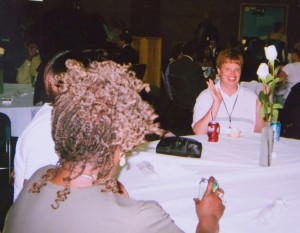
Aaron and Friends
Test Questions | Segregation or Inclusion?
Friends and family members send me newspaper stories about people with disabilities. Some stories make me shout with joy and others make me want to cry and give up. Often my friends can’t figure out which ones are which.
For those of you who have been following my blog, think of this as the end of semester test–one of those little Reader’s Digest sort of quizzes.
Below are three stories followed by three sets of multiple choice questions? What do you think of these stories? Please respond in the comments.
1. It’s always sunny in Life Town: (click here) The mocked-up village square allows children with disabilities to learn the skills they need in daily life. (Sunday, April 3, 2011 By Jason Shough THE COLUMBUS DISPATCH)
a. This story about inclusion makes me shout for joy.
b. This story about segregation makes me want to cry and give up.
c. I’m not sure.
2. A prom: An enchanted evening for students with intellectual disabilities (click here) A Pennsylvania high school held a prom Thursday night for students with intellectual disabilities. The event included many elements of the traditional high-school event, including dinner, dancing, pictures and entertainment. “Many of them will not attend another prom because of some of the limitations they have,” teacher Amanda Murray said. “But they deserve it. They never have an opportunity to be together without tons of rules outside a school situation.” Pittsburgh Tribune-Review.
a. This story about inclusion makes me shout for joy.
b. This story about segregation makes me want to cry and give up.
c. I’m not sure.
3. Story Three: see the picture, Aaron and Friends, at the top of the page.
Aaron, my son with the label of autism, is at a Spring Gala dinner and dance with his neighbors.
Susan and her husband, Charles, live next door to Aaron. They belong to a church at the edge of the neighborhood.
Susan invited Aaron and Jack (Aaron’s housemate) to join her and her husband for the church spring gala. They picked him up at the house and Susan introduced Aaron to the Minister and her friends, helped him get his dinner, danced with him, took pictures, and brought him home.
Aaron’s staff person was there to help if needed, but Susan and Charles did everything they could to make sure Aaron and Jack had a terrific night.
They told me later, they really enjoyed being with the guys and thought everyone had a great time. Susan was surprised Aaron enjoyed the band and watching all the people. She hopes to take them again next year.
a. This story of inclusion makes me shout for joy.
b. This story of segregation makes me want to cry and give up.
c. I’m not sure.
——————————————————————————-
Okay, now respond in the comments. No peeking at my response:) Remember your response is based on your paradigm and not mine, diversity is allowed. This isn’t a test where you have to please the teacher. This is a discussion of important issues.
Undecided?
Check out my previous article: Teachers| Segregation or Inclusion
Consider the core question: Does each of these activities lead toward the inclusion or segregation of people with disabilities?
For a definition of inclusion check out the article: What is Inclusion? plus, pictures of Aaron and Tommy at graduation.
Still Undecided?
Check out Norm Kunc: What’s your Credo of Support? Does this activity build authentic self-esteem and skills, or does it support the charity model?
Answer to Question 1: Mock Town by Barb McKenzie
Here is a response to the first article about the mock town from Barb McKenzie, a parent leader:
After seeing the title and reading the article below from today’s Columbus Dispatch newspaper I wondered, “Can benevolence get in the way of equality and ordinary opportunities?”
A generous person wants to help. We are taught to help others; it feels good to help others. But what perceptions might that ‘helper’ and ‘helpee’ relationship procreate? Is the ‘helper’ some how better than the ‘helpee’? Does the ‘helpee’ always need to be helped, never given the opportunity to share his or her gifts and enjoy the good feelings we get from our generosity? Do we believe that the ‘helpee’ has anything to share?
Why, especially when it comes to children or adults with disabilities, do we feel we must create special, pretend places to practice in and learn the skills to interact in society in the “real” world? Why can’t we try and figure out how to provide genuine, authentic, ordinary opportunities for all IN the “real” world? If natural supports or additional assistance are needed for any of us to be participating members of our neighborhood community, can’t we work together to figure out how to do that? Don’t we all learn better with and from each other in the real world, in the real school, in our real community?
Do our good intentions sometimes get in the way?
Mary’s Answer: Question 1
I agree with Barb. “Life Town” can never be a mock town. This artifical town reminds me of “safety town” for preschoolers and kindergartners to learn how to drive their bikes. Or the little pretend kitchens in kindergarten rooms. Or, Lou Brown’s famous cardboard bus that some special education teachers made for their classes in the ’70s.
There are some people who think that because a person’s IQ score says they function at a 6 year old level, doing pretend kindergarten type experiences makes sense. What the research shows people with disabilities have trouble generalizing to other environments, and because this was a one-time experience (not really a teaching experience with multiple trials and practice), and because the mock town was just that–mock.
In my mind, this whole experience does not promote inclusion in the community, instead it promotes segregation because it assumes the students need a protective environment and a “get ready” for the real world attitude. The twenty volunteers and the time, money could have been much better spent to practice “community” skills in the real community–they are high school students, they don’t need to be in a pretend environment. I’m embarrassed these teachers didn’t know any better. They should know more about authentic learning and functional curriculum.
Here is a new resource from a member of TASH if anyone is looking for best practice for people with severe disabilities.
“Systematic Instruction of Functional Skills for Students and Adults with Disabilities by Dr. Keith Storey .” This is a practical “how to” text for teachers and other service providers. The format, readability, and detailed description of instructional methodology make it a resource for instructors responsible for improving the skills of learners with disabilities.
Answer to Test Question 2: Dr. Cheryl Jorgenson
Here is a response from Dr. Cheryl Jorgenson from the University of New Hampshire:
This kind of segregation of students with disabilities should be part of our long-past history, not featured in a national news brief for educators in special education. The statement quoted by the teacher (Ms. Murray) that the students have limitations that “prevent” them from attending the regular prom is beyond the pale. Can CEC seriously be promoting or even acknowledging this practice? IDEA states that students with disabilities have the right to participate in extracurricular activities alongside their peers without disabilities.
I believe that CEC owes an apology to all students with intellectual disabilities and should make a commitment to publishing stories that promote the full membership and participation of all students with disabilities in school and community life.
Mary’s Answer: Question 2, Special Prom
I agree with Cheryl. In fact, Aaron and his friend Jenni went to his High School prom twice (with another couple who supported them). He thought it was great, though he said the black patent leather shoes hurt, the music was too loud and the tux had funny buttons.
Mary’s Answer to Question 3: Aaron at Spring Fling.
Going to the Spring Fling with the neighbors is exactly the kind of experience that builds inclusion. Let’s look at the definition of normalization and inclusion:
Is it an age-appropriate activity? YES
Will this be an activity the person would enjoy? YES
Does it take place in the real community? YES
Is there “natural proportion”? Are no more than 10% of the participants people with disabilities? YES
Will it be status-enhancing? Good for the person’s self-esteem? YES
Does the person with disabilities have the support they need? YES
Does the person with disabilities have the opportunity to blend into the normal environment and be like everyone else? YES
Is this an opportunity to meet new neighbors and establish new relationships? YES
Is there the chance of this happening again? YES
Many people think that because I do not like the “charity model” I am not Christian, or against churches or religion. In my mind, Susan, Charles and the other members of this church were practicing the Christian spirit and the best of religion.
I hope this make sense. There are many people who just cannot understand the differences between inclusion and segregation. To Aaron and our family, the differences make all the difference.
Keep Climbing: Onward and Upward:
“When we stop to lift one another up on the climb, we all reach a higher place.” Mimi Meredith
All my best,
Mary
Comments: What do you think?
Do these kinds of stories inspire you or drive you to distraction? What would you say to good, caring people who want to create segregated events? Would you participate? Is this better than just sitting in the classroom? What does inclusive or segregated events teach the community about people with disabilities?
by Mary E. Ulrich | Oct 21, 2015
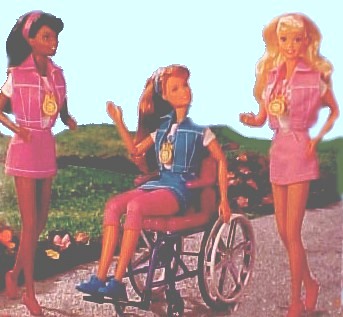
Barbie tries to become PC
Clueless Barbie
Some of the major stores are already advertising their holiday toy sales. This made me think of Barbie and her friends.
Some say the Barbie doll was the most influential icon of late 20th century American culture. In fact, she rated no. 43 on the 101 most influencial people who never lived (Click here).
Some say Barbie had it all: perfect body, perfect boyfriend and perfect everything.
Many little girls still think Barbie is the definition of beauty and a great role model, after all she has been a presidential candidate, an astronaut, in the arm services, in the business and entertainment worlds. Barbie didn’t even need a phone booth like Superman, all she had to do was change her shoes. In 2009, Barbie brought in $1.2 billion in annual revenue for Mattel.
But in my opinion, Mattel missed a powerful opportunity to be a leader for inclusion and community building–a real chance to make a difference in the world.
Mattel captured the feminist and toy market for “perfect” dolls, but it didn’t do as well with the non-white, “non-perfect” market. In the 1980s Barbie went multiracial and Mattel introduced Black Barbie, Hispanic Barbie and other dolls in their International Collection.
But these new “culturally diverse” dolls still had European features, and to me, seemed to be basically the original Barbie in costumes, with darker hair and skin.
Instead of becoming a leader, promoting sensitivity and understanding, Mattel reinforced the dominant cultural stereotype and dismissed the natural beauty of other races and cultures. A lost opportunity for all of us. Certainly a lost chance to teach tolerance and respect for people with disabilities.
In 1997, Mattel ignored even the basic “People First” language (click here) with Wheelchair Becky. When a little girl with cerebral palsy complained, they renamed the doll Share-a-Smile Becky. Most advocates would say, “Becky” would have been enough.
Good intentions aren’t enough.
Like many perfect people, Barbie and Mattel didn’t get past their good intentions. When everyone learned Becky’s long hair got caught in the rungs of her wheelchair, and Barbie’s Dreamhouse and expensive cars were not wheelchair accessible, Mattel folded.
Rather than make Barbie’s perfect world accessible and promote universal design and inclusion, Becky disappeared from Barbie’s neighborhood, er… store shelves.
Who wants to be perfect anyway?
But like many people with disabilities, Wheelchair Becky was resilient and found her own friends and adventures.
Last week someone sent me a web update on what Wheelchair Becky has been doing. Click here to join her for a beer and enjoy her wild ride– with Perfect Barbie nowhere in sight.
(Exaggeration is part of humor and comedy. If the pendulum moves a little too far for your taste, remember this is about making Becky more human. I liked that she is shown as an adult…for good or bad. Attitude and change are not child’s play.)
Seeing her here, there and everywhere, the Wheelchair Becky adventures reminded me of the building community activity I did with several classes around the book, Flat Stanley.

 photo credit: davidwatterson
photo credit: davidwatterson
Flat Stanley doing it right
Like Wheelchair Barbie, Stanley had an accident that resulted in some physical challenges. But Flat Stanley was also resilient, clever and he uses his unique physical condition to his advantage. Because he can now fit into an envelope he doesn’t have to worry about crowded flights and paying extra for luggage.
If you go to the Hall of Fame (click here) you will see Stanley has been in space, to the Academy Awards, to the White House and many exciting places.
In the picture we see Flat Stanley with a new friend in Kenya. Wouldn’t it be neat to have a pen pal from the other side of the world? Many teachers and school children think this personal connection is the best way to teach about different life styles and cultures.
The Flat Stanley Project is an international literacy and community building activity for students of all ages, teachers and families.
Check out http://FlatStanley.com for student and teacher testimonials, a phone app, templates for Flat Stanley and other characters including Flat Pilgrim, Flat Santa and the newest Flat Mrs. Claus.
For a history of the Flat Stanley project, click here.
My class used Flat Stanley and other Flat characters like Flat Pilgrim, Flat Santa, and the new one, Flat Mrs. Claus to become pen pals to let the children share their cultures with different people as well as practice their literacy skills.
Literacy and Service Learning Project
One group of preservice teachers was tutoring primary students with learning problems. They made the Flat Stanley Project into a literacy experience and a service learning project. We all donated a couple dollars and sent copies of the Flat Stanley books as well as art materials, disposable cameras and mailing supplies so our pen pal classes could exchange letters and pictures. We even found colored markers and pencils which allowed more diversity in colors and shades of skin tones. We included scissors which could be used by students who were left or right handed.
We paired the students in the literacy practicum from our small college town, with a class in an inner city in Charleston, SC and on an Indian Reservation in Montana. The project was a great success.
Dolls, Books, and People teach about diversity.
Inclusion is a way of life. And it includes Wheelchair Becky, Flat Stanley and yes, even Perfect Barbie.

 photo credit: Liz Henry
photo credit: Liz Henry
Comments: What are the lessons of Barbie and Friends vs. Flat Stanley? What could have been different? Can we use toys for social change?
Becky looks like she is going to do some social networking on her laptop. What do you think she would write? What about Flat Stanley and Flat Mr. and Mrs. Claus? And what recommendations do you have for Barbie and other toy manufacturers? Are there some lessons for the holidays? Tell us what you are thinking?
Keep Climbing: Onward and Upward
All my best,
~Mary
by Mary E. Ulrich | Aug 17, 2015
-
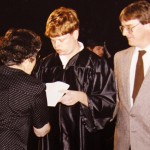
-
Aaron at Graduation 1997
-
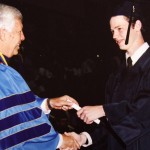
-
Tommy at Graduation
—
Check out the graduation pictures of my two sons.
What’s the same? What’s different?
BACK to SCHOOL Article 3
To celebrate the new school year here are some of my favorite posts:
Article 1: Why Do We Go to School?
Article 2: Back to School| A New Year of Learning
What is Inclusion?
The concept of INCLUSION is both simple and complex.
It means being able to go to the same school your brothers and sisters go to. The same school that is on the realtor’s fact sheet, you know the one: “If you buy this house, here is the neighborhood school you go to.” That’s simple, right?
In 1980 in Ohio, when my son Aaron turned 5 and was eligible to go to school, because he had the label of autism and developmental disabilities, he and other children with IQs below 50 were legally excluded from public schools. That’s complex.
It all changed because of Federal Legislation, yea those dang Government laws everyone hates.
When you suffer from exclusion and segregation, those Federal rules and regulations save the day.
History Lessons: Past
When new schools were built in the 50s-60s-70s-80s, the old white schools became “negro” schools. When even more new schools were built for the white children (think baby boomers), then the children with disabilities were moved up into the schools vacated by the “negroes.”
Schools: White to Negro to Handicapped to Demolished
The Education for All Handicapped Children Act was passed in 1975 and gave parents the right to a free appropriate public education, zero reject, related services, due process and the “least restrictive environment.”
At the time of the Neill Roncker and Aaron Ulrich due process hearings, the decrepit Dyer School was a handicapped-only school. Cincinnati Public Schools rented the school to the Hamilton County Board of Mental Retardation/Developmental Disabilities for $1.00 a year (Roncker hearing).
Parents and local Board of Mental Retardation officials were happy to be able to move out of church basements into the discarded school. They were also thrilled to be building new segregated facilities, handicapped only, with local levy dollars.
That was our court battle–to be able to ride the bus, go to school, eat lunch with typical kids… in our neighborhood school–not a “handicapped-only” school.
Inclusion is a civil right
“Inclusion is a right, not a special privilege for a select few.” – Federal Court, Oberti vs Board of Education.
For information about the history of children with disabilities check out the Minnesota DD Planning council’s excellent resource, Parallels in Time 2
History Lessons| Inclusion Today
Here is a recent video about a young woman with the label of autism. You will see her general education teacher, her parent, her inclusion facilitator, the general music teacher but most of all you will see the future citizens of our country.
Here is a picture of inclusion. A picture of hope. (Thanks to Donna Owens, OCALI)
Thaysa from Dan Habib on Vimeo.
Definition of Inclusion
Giangreco (see Resources) has defined the criteria for inclusion:
Students go to the same school as their brothers, sisters, and neighbors;
They participate in the same environments as their peers (lunchroom, bus, playground, classrooms);
According to their IEP, the student has the extra supports they need to be successful (therapy, adapted curriculum materials, an aide, teacher inservice);
There should be a natural proportion of children with/without disabilities, (if 10% of students are on IEPs in a school–no more than 10% of the students in any one class should be on IEPs).
An Inclusive Graduation Ceremony
So did you see any similiarities and differences in the graduation pictures above?
Almost everything about Tommy and Aaron’s Graduation ceremonies were the same. At the time, Lakota High School was one of the largest high schools in the state. Tommy and Aaron both had HUGE graduating classes held at the University of Cincinnati. Both had cheering parents and friends.
The difference between Aaron’s school experience and his typical brother Tommy’s, is evidenced in their graduation pictures above.
Aaron didn’t have to go through a segregated graduation ceremony and earn the right or prove he was ready to go to the inclusive celebration.
We did prepare by considering what would Aaron need to be added or subtracted from the typical graduation experience.
In his case, Aaron needed an extra support person, his wonderful teacher Mr. Mike Valdini. And, what needed to be subtracted–the mortar board hat!
I like to think our early battles for inclusion help the young children today—all of them, with and without disabilities.
Keep Climbing: Onward and Upward
All my best,
Mary
Comments:
It now seems like the concept of inclusion has been around forever. But like any civil rights movement, we often don’t move forward in a straight line. What are some of your experiences?
Related Posts:
The Values of Inclusion from Down Under
Down by the Ole Mainstream
–







